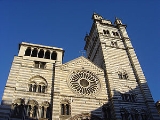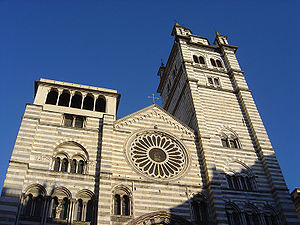
St. Lawrence Cathedral
Encyclopedia

The Cathedral of Saint Lawrence is a church in the Italian city of Genoa
Genoa
Genoa |Ligurian]] Zena ; Latin and, archaically, English Genua) is a city and an important seaport in northern Italy, the capital of the Province of Genoa and of the region of Liguria....
, the seat of the Archbishop of Genoa.
History
The cathedral was founded probably in the 5th or 6th century AD, devoted to St. SirusSyrus of Genoa
Saint Syrus of Genoa was a priest and later bishop of Genoa during the fourth century AD.Born at Struppa, he had a reputation for holiness and zeal. He died at an advanced age of natural causes and was buried in the city. He is the main patron of the city of Genoa.One tradition states that he...
, bishop of Genoa. Excavations under the pavement and in the area in front of today's façade have brought to light walls and pavements of Roman age as well as pre-Christian sarcophagi
Sarcophagus
A sarcophagus is a funeral receptacle for a corpse, most commonly carved or cut from stone. The word "sarcophagus" comes from the Greek σαρξ sarx meaning "flesh", and φαγειν phagein meaning "to eat", hence sarkophagus means "flesh-eating"; from the phrase lithos sarkophagos...
, suggesting the existence of a cemetery in the site. Later a church devoted to the Twelve Apostles was built, which was in turn flanked and replaced by a new cathedral dedicated to St. Lawrence martyr
Saint Lawrence
Lawrence of Rome was one of the seven deacons of ancient Rome who were martyred during the persecution of Valerian in 258.- Holy Chalice :...
, in Romanesque style. Money came from the successful enterprises of the Genoese fleets in the Crusades
Crusades
The Crusades were a series of religious wars, blessed by the Pope and the Catholic Church with the main goal of restoring Christian access to the holy places in and near Jerusalem...
.
The transferring of the cathedral favored the urbanization of the zone that, with the construction of it walls, in 1155, and the fusion of the three ancient city nuclei (castrum, civitas and burgus), became the heart of the city. The piazza, in absence of other public squares and centers of lay power, was the only city's public space for the whole Middle Ages
Middle Ages
The Middle Ages is a periodization of European history from the 5th century to the 15th century. The Middle Ages follows the fall of the Western Roman Empire in 476 and precedes the Early Modern Era. It is the middle period of a three-period division of Western history: Classic, Medieval and Modern...
. The cathedral was consecrated by Pope Gelasius II
Pope Gelasius II
Pope Gelasius II , born Giovanni Caetani , was pope from January 24, 1118 to January 29, 1119.-Biography:He was born between 1060 and 1064 at Gaeta into the Pisan branch of the Caetani family....
in 1118. Starting from 1133 the church had archiepiscopal rank. After the fire of 1296, provoked by fights between Guelphs and Ghibellines
Guelphs and Ghibellines
The Guelphs and Ghibellines were factions supporting the Pope and the Holy Roman Emperor, respectively, in central and northern Italy. During the 12th and 13th centuries, the split between these two parties was a particularly important aspect of the internal policy of the Italian city-states...
, the building was partly restored and partly rebuilt. Between 1307 and 1312 the façade was completed, the inner colonnades rebuilt with capitals and matronei added. The Romanesque structures remained pretty untouched, and frescoes of religious subject were also added.
Various altars and chapels have been erected between the 14th and 15th the century. The small loggia on the northeastern tower of the façade was built in 1455; the opposite one, in Mannerist style, is from 1522. In 1550 the Perugian architect Galeazzo Alessi
Galeazzo Alessi
Galeazzo Alessi was an Italian architect from Perugia, known throughout Europe for his distinctive style based on his enthusiasm for ancient architecture. He studied drawing for civil and military architecture under the direction of Giovanni Battista Caporali.For a number of years he lived in Genoa...
was commissioned by the city magistrates to plan the reconstruction of the entire building; however, he executed only the covering of the nave and aisles, the pavement, the dome and the apse.
The construction of the cathedral end in the 17th century. The dome and the medieval parts were restored in 1894-1900.
The cathedral had a fortunate escape on February 9, 1941 when the city was being shelled as part of Operation Grog
Operation Grog
Operation Grog was the name assigned to the British naval and air bombardment of Genoa and La Spezia between 6 and 11 February 1941, during the Second World War...
. Due to a crew error, the British battleship HMS Malaya fired a 381 mm armour piercing shell
Shell (projectile)
A shell is a payload-carrying projectile, which, as opposed to shot, contains an explosive or other filling, though modern usage sometimes includes large solid projectiles properly termed shot . Solid shot may contain a pyrotechnic compound if a tracer or spotting charge is used...
into the south east corner of the nave. The relatively soft material failed to detonate the fuse
Fuze
Fuze Beverage, commercially referred to as just Fuze , is a manufacturer of teas and non-carbonated fruit drinks enriched with vitamins. Currently the brand consists of five vitamin-infused lines: Slenderize, Refresh, Tea, Defensify, and Vitalize...
and the shell is still there.
The Museum of the Treasury lies under the cathedral and it collects jewellry and silverware from 9 AD up to the present. One of the most important piece is the Sacred bowl brought by Guglielmo Embriaco after the conquest of Cesarea and supposed to be the chalice used by Christ during the Last Supper and the Cassa Processionale del Corpus Domini.
References: .

